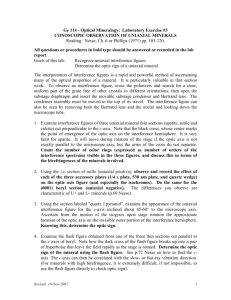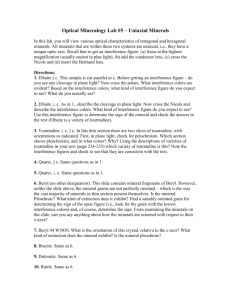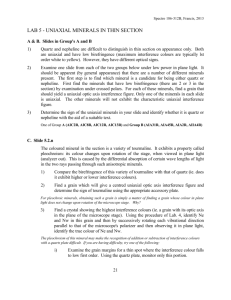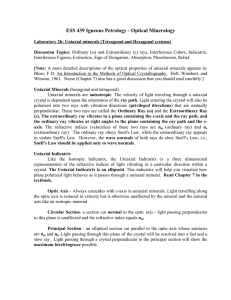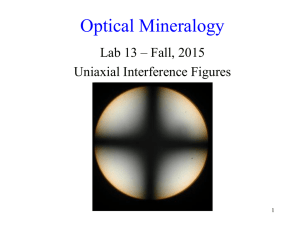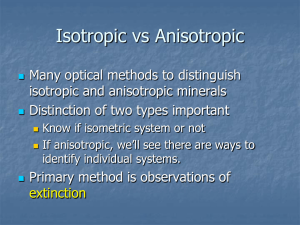LAB 3 THE OPTICAL CHARACTER OF UNIAXIAL CRYSTALS
advertisement
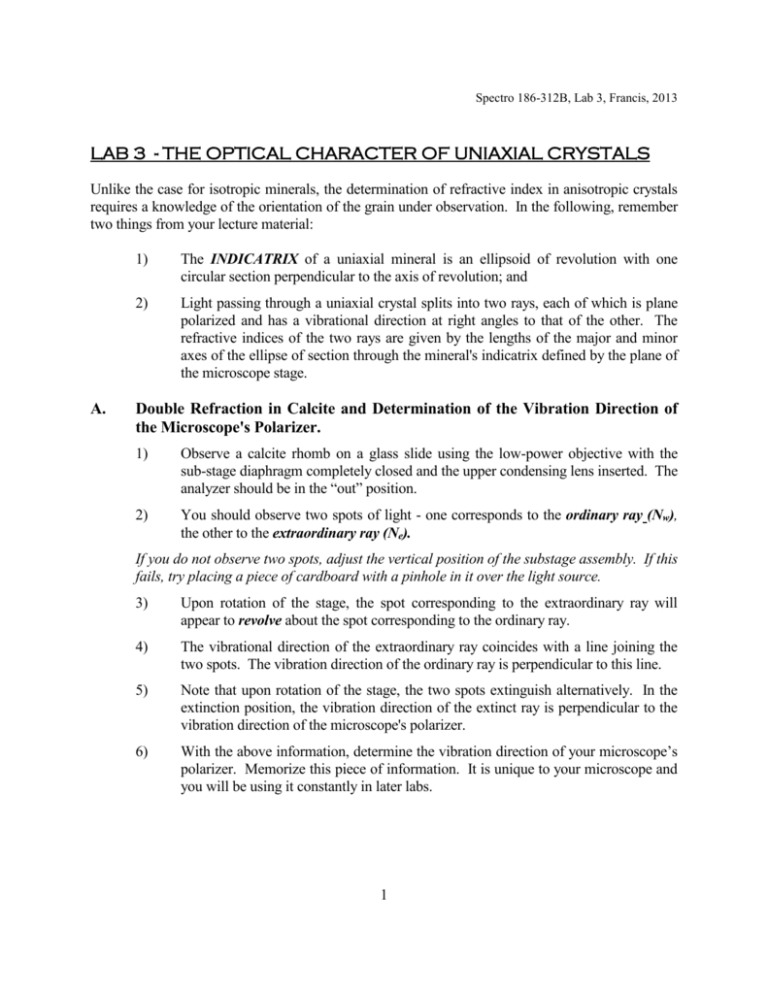
Spectro 186-312B, Lab 3, Francis, 2013 LAB 3 - THE OPTICAL CHARACTER OF UNIAXIAL CRYSTALS Unlike the case for isotropic minerals, the determination of refractive index in anisotropic crystals requires a knowledge of the orientation of the grain under observation. In the following, remember two things from your lecture material: A. 1) The INDICATRIX of a uniaxial mineral is an ellipsoid of revolution with one circular section perpendicular to the axis of revolution; and 2) Light passing through a uniaxial crystal splits into two rays, each of which is plane polarized and has a vibrational direction at right angles to that of the other. The refractive indices of the two rays are given by the lengths of the major and minor axes of the ellipse of section through the mineral's indicatrix defined by the plane of the microscope stage. Double Refraction in Calcite and Determination of the Vibration Direction of the Microscope's Polarizer. 1) Observe a calcite rhomb on a glass slide using the low-power objective with the sub-stage diaphragm completely closed and the upper condensing lens inserted. The analyzer should be in the “out” position. 2) You should observe two spots of light - one corresponds to the ordinary ray (Nw), the other to the extraordinary ray (Ne). If you do not observe two spots, adjust the vertical position of the substage assembly. If this fails, try placing a piece of cardboard with a pinhole in it over the light source. 3) Upon rotation of the stage, the spot corresponding to the extraordinary ray will appear to revolve about the spot corresponding to the ordinary ray. 4) The vibrational direction of the extraordinary ray coincides with a line joining the two spots. The vibration direction of the ordinary ray is perpendicular to this line. 5) Note that upon rotation of the stage, the two spots extinguish alternatively. In the extinction position, the vibration direction of the extinct ray is perpendicular to the vibration direction of the microscope's polarizer. 6) With the above information, determine the vibration direction of your microscope’s polarizer. Memorize this piece of information. It is unique to your microscope and you will be using it constantly in later labs. 1 Spectro 186-312B, Lab 3, Francis, 2013 B. Recognition of Uniaxial Minerals. 1. Identification of the uniaxial character of a crystal depends on recognition of the interference figure of the mineral, obtained by looking down the 'C' crystallographic axis, the axis of revolution of the index ellipsoid. To observe an interference figure, obtain a thin sheet of phlogopite. Examine it under high power with the upper condensing lens in position, and the sub-stage assembly near or at its maximum elevation. 2. After focusing, insert the analyzer and Bertrand lens and observe the interference figure. Although this mineral is biaxial, it produces an imitation of a uniaxial interference figure. The characteristic feature of this figure is the presence of a black cross or 'isogyre' which remains intact as the stage is rotated. This cross is surrounded by concentric rings of interference colours whose retardation increases away from the centre of the cross. Fig. 3-1. Uniaxial Optic Axis Interference figure: 2 Spectro 186-312B, Lab 3, Francis, 2013 C. Uniaxial Minerals in Oils. 1) Prepare a mount of powder # 3.1 in an oil of R.I. = 1.55. The grains of this mineral are relatively equant in shape, and thus grains of all orientations will be found on the slide. By choosing grains that have the lowest interference colours (grey-white to black for all positions of the stage), find a grain that give an optic axis interference figure. Remove the Bertrand lens and analyzer and determine whether the R.I. of this grain is higher or lower than that of the oil. 2) Find a grain that gives a uniaxial flash figure by examining grains exhibiting the highest interference colours (greatest number of concentric colour bands). Remove the Bertrand lens and rotate the grain to an extinction position. Remove the analyzer and perform an R.I. comparison. Now rotate the stage 90o and perform the test again. Are the results the same, if so why? Is the mineral uniaxial (+) or (-)? Hint: You determined the magnitude of Nw with respect to the oil in step C-l. D. Examination of a Quartzite Thin Section. Find the clear grains in plane-polarized light that have the lowest interference colours in crossed-polars (grey-white to black for all positions of the stage); they are most likely to have near vertical "C" axes and give you optic axis interference figures. Try to image an optic axis interference figure. Now find a grain with the largest number of interference colour bands (highest retardation) that will give you a uniaxial flash figure using the Bertran lense. Normally you will see the field of view turn dark 4 times in one rotation of the stage, but a slight rotation (2-4o) from extinction causes the dark shadow to break into two curved shadows that leave the field of view in opposite quadrants. You can identify the 'C' axis (Nε) in such a grain by observing the quadrants in which the shadows leave the field of view upon slight rotation of the grain from the extinction position. The rule is that, as the stage is rotated from the extinction position, the two shadows leave the field of view in the quadrants into which the C axis (Nε) is moving. 3
